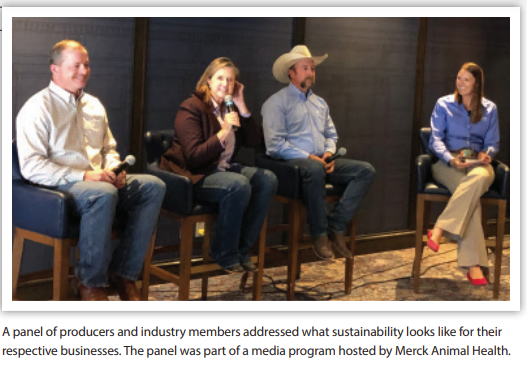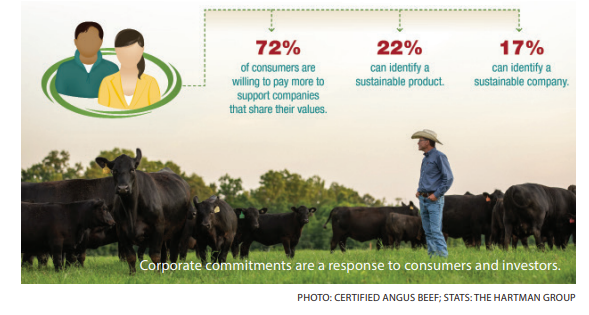Embrace the 'S' Word (Nope, it doesn't have 4 Letters)

When discussing sustainability, Frank Mitloehner likes to share a story how he overheard two beef producers talking about a presentation he had just made on the topic.
“One said, ‘I like (Mitloehner), but I wish he wouldn’t use the S-word all the time,’” he recalls.
The two cattle producers were industry leaders in Texas, says Mitloehner, professor and air quality Extension specialist in the department of animal science, University of California, Davis.
That was 20 years ago, he adds. Since then, the same two producers have helped organize sustainability conferences in the state. Why the change? They told Mitloehner that even if they didn’t agree with everything he said about sustainability, that’s “not as important as it is for us to listen to our customers’ demands.”
Fast forward to 2022, and sustainability has grown increasingly important for producers and other members of animal agriculture, including veterinarians, says Ben Weinheimer, president and CEO, Texas Cattle Feeders Association.

“Veterinarians are lifelong learners and lifelong educators, and this is one of those topics the veterinary community could extend the conversation on with producers,” he adds. “They have the ability to be an advocate for sustainability and put the conversation around it in language producers can understand.”
What The Heck Is It?
Everyone has a bit of a different take on what sustainability is or what it involves. Mitloehner, for instance, says the five pillars of sustainability are environment, animal welfare, food safety, people/labor and financial viability.
Kansas cattleman Debbie Lyons-Blythe has a similar perspective. “I’ve given an awful lot of thought to what my definition is for sustainability, and I think it’s pretty simple: take care of the land, take care of the animals, take care of the people, and make money. And if you have those four things, pretty much, you can be sustainable,” she says. Lyons-Blythe and her family own a registered Angus operation and a commercial cow-calf operation in the Kansas Flint Hills near White City, Kan.
Jake Cowen, Cowen Cattle Company, backgrounds and feeds out cattle near Benjamin, Texas, 125 miles east of Lubbock. He agrees with Lyons-Blythe and adds his take on sustainability.
“Sustainability of cattle production on our operation means being the most efficient we can,” Cowen says. “From an animal health and animal welfare standpoint, we do the best we can to source and grow the best feed ingredients we can. We constantly strive to do a better job. We’re big on clean water, good feed and good handling of cattle.”
Measure, Record Communicate
Lyons-Blythe says the transfer of knowledge is vital to sustainability. One way she and her husband, Duane, are accomplishing that with their five children is through using what she calls a management calendar and a grazing management plan. It’s their take on the view that you can only measure the success of what you track.
“As a registered breeder, I am a huge recordkeeper. I am absolutely comparing my weights from year to year, and I follow my animals through the feedyard,” she says.

Cowen says he and his team source code a lot of their cattle. “We pay attention to source codes when it comes to death loss, morbidity, that sort of thing,” he says.
Cowen adds that he “really leans” on his nutritionist and veterinarians for information and support.
“I’ll pick up the phone, call and ask, ‘hey, what are you seeing in some of these other stocker operations in a 150-mile radius’ just to glean information we can use to improve on our doctoring protocol or to change the source of cattle or figure out if there are other changes we might want to make to increase our efficiencies.”
Start With Small Steps
Lyons-Blythe says using sustainable practices doesn’t have to be difficult. “Number one, make sure all the cows are productive, right tag your calves, trace back to the cow and make sure that cow is productive. Those are quick, easy ways to increase your sustainability,” she says.
“The next thing I’d say is get a grazing management plan. I’m surprised that not everybody has them. The better the plan, the better manager you can be and, of course, get BQA certified. I think the other thing that’s fundamental to all of this is to make sure you write it all down. Document, document, document.”
Lyons-Blythe encourages veterinarians to help producers complete a self-assessment of their operations to see how they measure up against the U.S. Beef Industry Sustainability Framework standards.
https://nobleapps.noble.org/usrsbassessment
“By answering a few questions, you can get a quick feel for where an individual ranch or stocker operation stands in the process. It’s a great tool, and it can show their producers that sustainability doesn’t have to be hard,” she says.
Sustainability is not Going Away. What are You Going to do With It?







